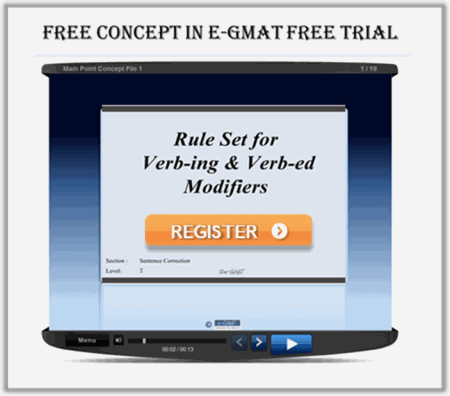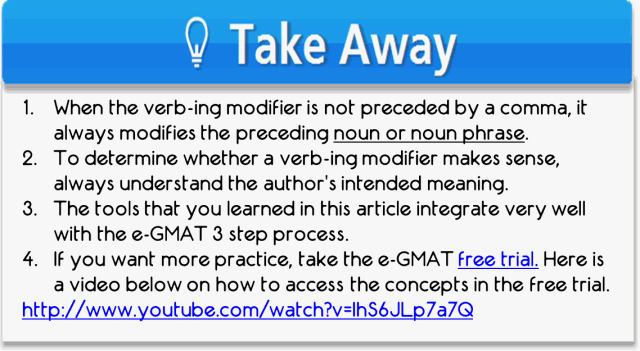I have 2-3 doubts.
If the choice e would have been Most of them as large as or larger than Jupiter,circling....--Correct right? because the relative pronoun according to sentence structure would refer to 80 massive planets
Doubt 2: you mention that mostly is an adverb modifying adjective "atleast as large as". i couldn't catch it any ointers here?
Choice C :most of them at least as large e as Jupiter, circling: Correct. This choice corrects the error of choice A by using the correct idiom “at least as large as Jupiter” to convey the intended meaning.
Concern: this is an example where I see modifier is preceded by a , as mention int he question(not sure if this is a typo) so I follow Rule Set 1 should-->It will modify the preceding clause and will be inline with the subject of the main clause, the clause has subject -"astronomers" and "have detected" as verb, now if" circling" doen't align with astronomer so i din select it. I selected C because of this. However I couldn't figure out the error mentioned in Doubt 1( din see the mostly error though)
Here according to Rule 2 if no verbing is preceded by o , it should modify the noun preceding it which is 80 massive planets and not --Jupiter coz the information---Juitper is a modifier providing more info..
if no , present most of them at least as large as Jupiter, circling circling would be right (referring to preceding noun entity-80 massive planets.
Please help me understand if my understanding of the concept is clear or what am i missing here??
VERB-ING MODIFIERS PART 2
In our
first article on verb-ing modifiers, we discussed function of this modifier when used with a comma. In this article we will explain the function of the verb-ing modifier when the modifier is placed after the clause and is NOT preceded by a comma. To refresh your memory, in a sentence there are three general places where this modifier appears. In each placement, the modifier plays a specific role. These places are:

1. Placed after a clause PRECEDED by a comma (explained in the first article)
2. Placed after a clause NOT PRECEDED by a comma (explained in this article)
3. In the beginning of a clause followed by a comma (Please view the Verb-ing concept in the
e-GMAT free trial)
RULE SET #2
The placement of the verb-ing modifier after a clause without a comma brings us to the second rule set for this modifier.
Let’s understand the application of this rule set through simple examples first.

SIMPLE EXAMPLE
•
Mary made a beautiful bouquet
releasing divine aroma.
In this sentence
“releasing…” is a verb-ing modifier that is not preceded by a comma. In this construction, “releasing…” modifies the preceding noun “bouquet”. The sentence means that Mary made a beautiful bouquet and that bouquet releases a divine aroma. So the modifier describes the noun "bouquet".
 Understanding Intended meaning is the key:
Understanding Intended meaning is the key: As you would have noticed, the key to deciding whether to use a verb-ing modifier, and if to use one, whether to use one with a comma depends on the intended meaning of the sentence. If the logical intended meaning is such that the verb-ing modifier should modify the preceding noun or noun phrase, then we should use the verb-ing modifier without a comma. On the other hand, use the verb-ing modifier with the comma if the author’s intention is to express additional information about the preceding clause or the result of the preceding clause. Either way, to make this distinction it’s important to understand the logical intended meaning. View the free concept on
e-GMAT if you need further clarification (and audio visual representation).
OFFICIAL EXAMPLE
Let’s now take an
official example and apply the tools that we have learned so far. Note that in this example we will only analyze the sentence with regards to the verb-ing modifier. The sentence construction for choices A and B is same as it pertains to the usage of verb-ing modifier.
OG 12#133 – Choice BLast week local shrimpers held a news conference to take some credit for the resurgence of the rare Kemp's ridley turtle, saying that their compliance with laws
requiring turtle-excluder devices on shrimp nets is protecting adult sea turtles.
To decide whether the usage of verb-ing modifier make sense, let’s understand the author’s Intended Meaning.
Intended meaning:To understand the intended meaning, we will split the sentence into clauses to understand its structure. Take the Sentence Structure concepts in the free trial if you have trouble in splitting the sentence into clauses and phrases. Let’s continue.
• Last week
local shrimpers held a news conference to take some credit for the resurgence of the rare Kemp's ridley turtle, saying
• that
their compliance with laws requiring turtle-excluder devices on shrimp nets
is protecting adult sea turtles.
This sentence says that last week local shrimpers called for a news conference. They did so to take come credit for the resurgence of the rare Kemp’s ridley turtle. They informed in the conference that they comply with laws that require turtle-excluder devices on shrimp nets. This action is protecting adult sea turtles.
The verb-ing modifier “requiring” is not preceded by a comma and hence correctly modifies the preceding noun “laws”. The meaning is clear - these laws require the shrimpers to use turtle-excluder devices on shrimp nets. Therefore, the sentence is correct as it is.
AN INSTANCE IN WHICH VERB-ING IS NOT CORRECT
We will now take an example in which Verb-ing is not correct. This example is from the exercise of the previous article.
In three months, biologist Glauco Machado gathered enough information about large numbers of a relatively unstudied order of
arachnids to persuade an ant specialist at the university to advise him and to publish his first scientific paper.
A. arachnids to persuade an ant specialist at the university to advise him and to publish
B. arachnids, persuading an ant specialist at the university to advise him and publishing
C. arachnids persuading an ant specialist at the university to advise him and publishing
Let’s use the tools to determine whether verb-ing modifier makes sense.
STEP 1: (Intended) MEANING ANALYSISThe sentence says that in three months Machado gathered enough information about a huge number of comparatively unstudied order of arachnids. He gathered all information with two purposes in mind:
a. he wanted to persuade an ant specialist at the university to advise him
b. he wanted to publish his first scientific paper
STEP 2: ERROR ANALYSIS• In three months,
biologist Glauco Machado gathered enough information about large numbers of a relatively unstudied order of arachnids to persuade an ant specialist at the university to advise him and to publish his first scientific paper.
This sentence has just one subject-verb pair, meaning it has only one clause. The SV pair is accounted for. The purposes of gathering all the information have been correctly written in “to verb” form. These two purposes are also correctly joined with “and”. Hence, there is no error in this sentence. The sentence is correct as is.
STEP 3: POELet us now do the POE to see what makes the other two choices incorrect.
A. arachnids to persuade an ant specialist at the university to advise him and to publish:
Correct as we discussed during error analysis.
B. arachnids, persuading an ant specialist at the university to advise him and publishing:
Incorrect. Here both the verb-ing modifiers are preceded by comma, implying that they modify the entire preceding clause. Hence, now the sentence means that Machado gathered all the information and this action resulted into two things:
a. he persuaded the ant specialist, and
b. he published his first scientific papers.
This is certainly not the intended meaning of the original sentence. The original sentence talks about purpose. Per this choice, Machado’s gathering information actually led to the persuasion of the ant specialist and the publication of the first scientific paper. Hence, this choice is grammatically correct but certainly alters the intended meaning and is thus incorrect.
C. arachnids persuading an ant specialist at the university to advise him and publishing:
Incorrect. In this choice, the verb-ing modifiers appear without comma. Here, both “persuading” and “publishing” modify the preceding noun “arachnids”. Now, per this choice, the sentence means that Machado collected information on certain arachnids and these arachnids did the jobs of persuading the ant specialist and publishing first scientific paper. This is absolutely illogical. This is a case where verb-ing modifier without a comma does not make sense.
APPLYING THE RULE SET TO GMATPREP QUESTION
Ok, so now that we understand how to use the new tools that we have learnt, lets add them to our arsenal and use the
e-GMAT 3 step process to solve a GMAT PREP question.
GMAT Prep Question:In the past several years, astronomers have detected more than 80 massive planets,
most of them as large or larger than Jupiter, which circle other stars.
A. most of them as large or larger than Jupiter, which circle
B. most of them as large or larger than Jupiter and circling
C. most of them at least as large as Jupiter, circling
D. mostly at least as large as Jupiter, which circle
E. mostly as large or larger than Jupiter, circling
Let us now apply the
e-gmat three-step process to solve this one. We will begin with the first step that is:
MEANING ANALYSIS:The sentence says that in the past few years, astronomers have detected more than 80 massive planets. These massive planets are either as large as Jupiter or larger than Jupiter. These massive planets also circle other stars.
ERROR ANALYSIS:• In the past several years,
astronomers have detected more than 80 massive planets, most of them as large or larger than Jupiter,
•
which circle other stars.
This sentence uses a mix of two idioms – “as X as” and “X larger than” – in the form of “as large or larger than”. This is incorrect. We must use the idiom correctly in its entirety to present the correct comparison.
Notice the modifier – “which circle…”. This relative pronoun modifier modifies the noun “80 massive planets”. Some of you may wonder that “which circle…” modifies the closest noun “Jupiter”. This is not correct. And this is where logical meaning and understanding the sentence structure comes to our aid.
Notice that “most of them as large or larger than Jupiter” is a modifier that provides additional information about the 80 massive planets. This modifier is encapsulated in a comma pair. So even if we remove this modifier from the sentence, the meaning will not be altered. So for the sake of our discussion, let’s remove this modifier:
• In the past several years, astronomers have detected more than 80 massive planets
, most of them as large or larger than Jupiter,which circle other stars.
Now as you can see, “which circle…” modifies the noun phrase “80 massive planets”. Remember that the comma that precedes “which” does not separate “which” but is part of the comma pair that separates the modifier "most of them…" from the rest of the sentence.
We will now find the correct choice from the remaining 4 choices.
POE: A. most of them as large or larger than Jupiter, which circle:
Incorrect for reasons discussed above.
B. most of them as large or larger than Jupiter and circling:
Incorrect. i. This choice repeats the idiom and parallelism errors of choice A.
ii. A modifier is not separated from the entity it modifies by using “and”.
C. most of them at least as large as Jupiter, circling:
Correct. This choice corrects the error of choice A by using the correct idiom “at least as large as Jupiter” to convey the intended meaning.
Furthermore, notice the use of modifier - “circling…” . This modifier modifies the noun entity that precedes it – “more than 80 massive planets”. As we discussed in the sentence structure discussion for choice A, this modifier does not modify the immediately preceding noun "Jupiter". This is a verb-ing modifier that is not separated from the preceding clause by a comma and hence modifies the preceding noun entity.
At this time we should also pay attention to the logical meaning of the sentence. We have determined already that “circling…” modifies “80 massive planets” from grammatical standpoint. From logical standpoint also, “circling” must modify “80 massive planets” because it is a universal fact that Jupiter revolves around the Sun and no other star. Hence, there is no logical way that “circling” can modify “Jupiter”. It should modify “80 massive planets”.
D. mostly at least as large as Jupiter, which circle:
Incorrect. Use of “mostly” is incorrect here. Now it is an adverb that refers to the adjective following it “at least as large as”. This is non-sensical.
E. mostly as large or larger than Jupiter, circling:
Incorrect. i. Repeats the same “mostly” error of choice D.
ii. Repeats the idiom error of choice A.










